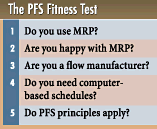 Table 1
Table 1
The choice of a scheduling technique can hardly compare to life's great
philosophical questions such as "Is there meaning to my existence?"
Nevertheless if manufacturing is your game and scheduling your name, mundane
questions like "Which scheduling technique is best?" may have
a significant impact on your professional existence.
Process flow scheduling is a type of scheduling logic used in over 600 flow
manufacturing plants. Like MRP and JIT, process flow scheduling (PFS) is
not a specific software package but a general procedure for scheduling in
certain manufacturing environments. Just as with MRP and JIT systems, there
are many different ways of implementing PFS principles. Can PFS help you?
Maybe. Maybe not. It depends on your situation.
Now, we are professors by trade and are quite fond of tests. So we have
designed a short fitness test to determine if PFS can help you. You should
recognize that failing the fitness test is more a reflection on PFS and
your manufacturing environment than on you. Failure merely indicates that
another scheduling technique will better fit your requirements. Like most
really interesting tests, there are no right or wrong answers to our test.
However, to help you grade the test we will present a few of our thoughts
on each of the questions.
Just a word about our interests before we get under way. We are not in the
software business. As professors we research, develop and promote new ideas.
That is what this article is about -- our ideas for new scheduling systems
framework.
The PFS Fitness Test
Take a moment and look over the fitness test in Table 1.
 Table 1
Table 1Answer the questions you can right now. If a question needs clarification,
wait and answer it after reading our discussion.
If you answered this question no, you may have more company than you
think. An article in the Dec. 1, 1988, Datamation, "Post-MRP
II: What Comes Next?" by M.J. Foley, indicated fewer than one in seven
manufacturing firms were using MRP II. These results beg the question, "If
so many firms are not using MRP, then just what are they using?" If
you don't use MRP for plant scheduling, you may already use PFS principles.
You may simply not be aware of this relatively new, integrative framework
and the software that employs these scheduling principles. To find out,
read on.
If you answered yes, you may still be a candidate for PFS. For this question,
let us only consider those elements of an MRP II system that are used for
scheduling. These are the modules for master scheduling, material requirements
planning, capacity requirements planning and the "closed-loop"
planning technique which links them together. If you have replaced these
MRP II modules with another scheduling procedure, you too may already be
using PFS principles.
This question assumes that you are one of the minority of manufacturers
that are using MRP. If you are quite happy with your MRP system, then PFS
is probably not for you. We humbly suggest that you quit reading this article
now--unless your are just plain curious. PFS is only for those who are dissatisfied
with MRP scheduling logic.
Assuming that you are on bad terms with MRP, let's examine why. Do you feel
that MRP does not give you enough detail for scheduling plant operations?
Do you have problems with the way MRP schedules capacity? Do the fixed lead
times in an MRP system create problems for you? Do you hate opening and
closing all those work orders? Do you feel that computer performance has
changed significantly over the last two decades and that perhaps your scheduling
technology should too? If you answered yes to several of these questions,
you should consider replacing the scheduling modules in your MRP II system.
PFS may be the answer. Then again, it may not. Read on.
Let's begin the discussion of this question by clarifying the definition
of flow manufacturing. In flow manufacturing plants, materials flow through
stages of production with relatively fixed routings. For example, in a chemical
plant, materials may be processed in successive stages of separation, reaction
and packaging. Flow manufacturers often use process flow charts to describe
how products are made in their plants. In contrast, job shop manufacturers
tend to specify routings for individual parts.
If you answered that you are a flow manufacturer, then you are a prime candidate
for PFS. Currently PFS is used in flow manufacturing industries such as
chemical, food processing, paper, brewing, high volume consumer products,
pharmaceuticals, semiconductors, rubber and petroleum.
If you answered no, then we will assume that you are a job shop manufacturer
that is having problems with MRP's scheduling logic. Although PFS cannot
help in your manufacturing environment, you really should consider replacing
or augmenting your MRP scheduling modules with a job shop-oriented, finite
capacity scheduling system. You should note that finite scheduling systems
vary widely. One group of finite capacity scheduling systems are PFS systems.
Another group is for job shop manufacturers. As you examine finite scheduling
packages, make sure you are looking at those systems designed for job shop
manufacturers. Since PFS does not fit job shop manufacturers, you can go
look for an appropriate article on finite capacity scheduling now. PFS is
not going to help you.
At this point we are assuming that you are a flow manufacturer and do
not want to use MRP scheduling logic. The question remains, do you really
need a computer to help you develop schedules? If you answered no, we will
assume that you have been quite successful with your JIT system and have
the stable demands, easy product changeovers and excess capacity that JIT
systems require. Or on the other hand, you may have a relatively simple
manufacturing environment that just doesn't need a computer-based scheduling
system. If you are doing quite well without computer assisted scheduling,
then don't change-customers don't buy your schedules. You too can go on
to another article now. PFS won't help you either.
If you answered yes, we will assume that you need efficient capacity utilization
and forward visibility of future production, demand and inventories. You
may also be in an environment where production sequences and product changeovers
are an important consideration. If so, you are a good candidate for PFS.
Read on.
At this point we are assuming that you are a flow manufacturer needing
some type of computer-based scheduling system and recognize that MRP is
an awfully poor fit. Will PFS help? Just what is PFS? To answer these questions,
let's take a quick look at the three PFS principles given in Table 2. These
principles are the foundation of all PFS systems.
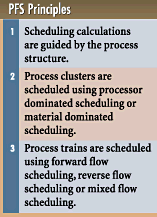 Table 2
Table 2Calculations Guided by Process Structure
The first, and most important, principle concerns how schedules are developed.
Process flow scheduling uses the process structure to guide scheduling calculations.
In contrast, MRP uses the bill of material, i.e., the product structure,
to guide its scheduling calculations.
Process flow scheduling uses some special terminology to describe processes
in a way meaningful for scheduling.
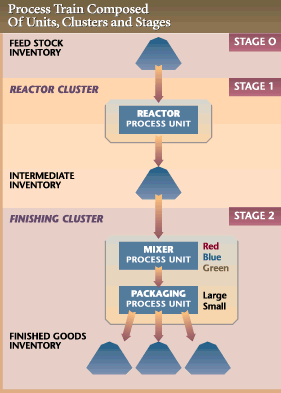 Figure 1
Figure 1Figure 1 shows a process train that is composed of process units, clusters
and stages. A process unit is a collection of process equipment that shares
the same schedule.Thus, a bank of heat exchangers, a reactor and some distillation
towers may comprise a single process unit because they are all scheduled
as a single unit. Every process unit must have a schedule and every schedule
must have a process unit.
Process clusters consist of one or more process units grouped together for
various scheduling purposes. Process units within a cluster have different
schedules; however, these schedules are closely linked to each other. Take
for example the finishing cluster shown in Figure 1. The mixing unit produces
red, blue and green products. These feed a packaging process unit which,
in turn, fills large and small containers. Note that there is no inventory
between the mixing and packaging operations. Thus, when the mixing unit
is producing red product, the packaging unit must also be processing red
product. However, since the packaging schedule must specify size as well
as color, the schedules for the mixing and packaging units are slightly
different. Although the schedules are different, they are closely coupled
because of the lack of inventory between the two process units.
Process stages are groups of process clusters that are decoupled from preceding
and succeeding stages by inventories. Thus, for the process train shown
in Figure 1, the finishing cluster schedule in stage 2 is decoupled from
the reactor cluster schedule in stage 1 by intermediate inventories. Finally
we have process trains. Process trains are sequences of process stages which
can be scheduled more or less independently from other process trains within
the same plant.
Process flow scheduling uses this structure of process units, clusters,
stages and trains to build schedules. The procedure generally begins by
scheduling the most difficult process clusters first and then moves on to
schedule the other process clusters. The cluster schedules are often constrained
by guidelines such as production sequences, run lengths and target minimum
and maximum levels for each inventory. The exact scheduling details vary
widely from one situation to the next, but the underlying concept of using
the process structure to guide scheduling calculations is central to all
PFS systems.
Cluster Scheduling Alternatives
The second PFS principle concerns the two alternatives for scheduling process
clusters: processor dominated scheduling (PDS) and material dominated scheduling
(MDS). Many flow manufacturers have well defined capacity limits for process
clusters and develop finite capacity schedules for these clusters before
checking inventories. Figure 2 illustrates this procedure.
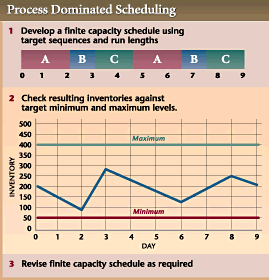 Figure 2
Figure 2The other cluster scheduling alternative is material dominated scheduling.
MDS first develops a material plan for a cluster and then checks the processor's
capacity. This procedure is similar to MRP, but there is one very important
difference. An MRP system first develops a material plan for all clusters
in the plant and then checks inventories. In contrast, a MDS technique checks
both material and capacity for a cluster before scheduling other process
clusters in the plant.
Train Scheduling Alternatives
The third PFS principle concerns the way in which process trains are scheduled.
Figure 3 illustrates each of the three alternatives. Many flow manufacturers
use a reverse-flow scheduling procedure. This procedure first schedules
the final stage in the process structure, and then successively schedules
the earlier stages.
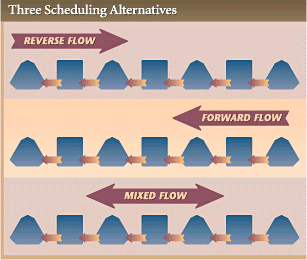 Figure 3
Figure 3Reverse-flow scheduling tends to be driven by customer demands and backward
schedules through the process structure to raw material requirements.
Forward-flow scheduling is not as common as the other two alternatives.
Here scheduling begins with the first stage in the process flow and proceeds
forward through the process structure until the final stage is scheduled.
Forward flow scheduling is most common in operations that are driven by
the arrival of key raw materials. This situation occurs in some food processing
operations that cannot store agricultural products before their processing.
Mixed-flow scheduling is quite common. Mixed-flow scheduling may focus on
a critical process cluster that occurs at an internal stage within the process
flow. Scheduling begins with this bottleneck operation and then proceeds
forward and backward through the process structure.
Now comes the critical question. Do these three principles seem to make
more sense for scheduling your plant than other scheduling frameworks? If
so, read on.
For Those Who Passed
What should you do if you passed the PFS fitness test? Well, again, the
answer depends a lot on your individual circumstances. If you think you
passed the fitness test but are still somewhat confused about PFS, we are
not surprised. Our explanation of PFS was quite brief and perhaps you should
read more in the APICS book. (See the sidebar for details.)
If you passed the fitness test but are not happy with your current system,
perhaps you should consider a change. If you are using MRP, you really should
take a look at switching to a PFS system. On the other hand, maybe you are
using a spreadsheet-based system which employs PFS principles, but the system
is quite difficult to maintain. If you are in this category, you may want
to consider one of the commercial PFS packages.
If you are already using PFS and are happy with your system, then not much
action is warranted. On the other hand, most systems can be improved and
you may want to consider a variety of situation specific enhancements to
your PFS system.
Process flow scheduling provides a framework for integrating the scheduling
practices of many flow manufacturing companies. PFS is a fundamentally different
way of approaching scheduling than either MRP or JIT. Process flow scheduling
is not appropriate for all manufacturing. However, for those of you who
passed the fitness test, PFS provides an appropriate framework for your
scheduling activities.
Further Reading
"Process Flow Scheduling," By Sam G. Taylor and Steven F. Bolander,
168 pp./1994. Available Exclusively from APICS. Call APICS Customer Service
at (800) 444-2742, Ask for Stock #01294.
Process Flow Scheduling Vendors
AVYX, Inc., 23 Inverness Way East, Suite 100, Englewood, CO 80112-5708.
Contact: Bryan Scott
Scheduling System: Advanced Scheduling Environment
Chesapeake Decision Sciences, Inc., 200 South Street, New
Providence, NJ 07974. Contact: Walt Beadling;
Scheduling System: MIMI
Fygir Logistic Information Systems, 25 Burlington Mall Road,
Suite 300, Burlington, MA 01803.
270-0683; .
Scheduling System: GRIP
Manugistics, Inc., 2115 East Jefferson Street, Rockville,
MD 20852. Contact: Arlene Gerst;
Scheduling Systems: Manugistics Finite Capacity Scheduler, Manugistics Constrained
Production Planning.
Numetrix, Ltd., 655 Bay Street, Suite 1200, Toronto, Ontario,
Canada M5G 2K4. Contact: Veerle Schengili;